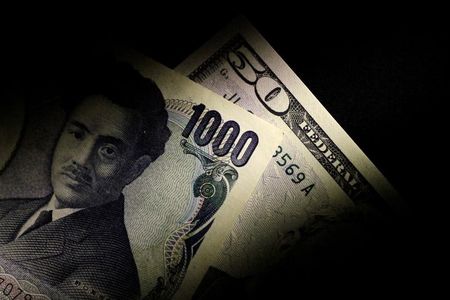
Investing.com– Most Asian currencies rose on Thursday as the dollar lost ground after comments from Federal Reserve Chair Jerome Powell sparked more optimism over interest rate cuts, putting upcoming inflation data squarely in focus.
Regional currencies regained some ground against the dollar as traders largely maintained bets on a September interest rate cut by the Fed. Thursday’s consumer price index inflation report is set to offer more cues on this front.
But weak economic data saw the Japanese yen continue to lag its peers, with the currency remaining close to its weakest level in 38 years.
Dollar retreats with CPI data in focus
The dollar index and dollar index futures both fell about 0.1% in Asian trade, extending overnight losses after Powell reiterated his outlook for the U.S. economy achieving a soft landing.
A key point of pressure on the dollar was Powell stating that the Fed did not need to see inflation falling below its 2% target to begin cutting rates, only that the bank needed enough confidence that inflation was easing.
This put upcoming CPI data squarely in focus, with any signs of easing inflation likely to spur increased bets on a rate cut.
The CME Fedwatch tool showed traders maintaining a 72.5% chance the Fed will cut rates by 25 basis points in September.
Japanese yen weak, USDJPY remains above 161
The Japanese yen continued to lag its peers, seeing little relief even as the dollar retreated and the outlook on U.S. interest rates brightened. The USDJPY pair hovered well above 161 yen and remained close to levels last seen in 1986.
Weak core machinery orders data for May signaled persistent weakness in the Japanese economy, furthering the notion that the Bank of Japan will have limited headroom to hike interest rates further.
Still, the threat of potential government intervention in currency markets kept the yen’s decline relatively staggered.
Broader Asian currencies mostly firmed on the prospect of an eventual reduction in U.S. interest rates.
The Australian dollar’s AUDUSD pair rose 0.2%, even as data from the Melbourne Institute showed expectations for Australian inflation cooled slightly.
The Chinese yuan’s USDCNY pair fell 0.1%, with the Chinese currency seeing some relief after underwhelming inflation data on Wednesday.
The South Korean won’s USDKRW pair fell 0.3% after the Bank of Korea left interest rates unchanged for a 12th consecutive meeting. But some policymakers raised the prospect of an interest rate cut within the next three months.
The Singapore dollar’s USDSGD pair fell 0.1%, while the Indian rupee’s USDINR pair moved little.
This post is originally published on INVESTING.


